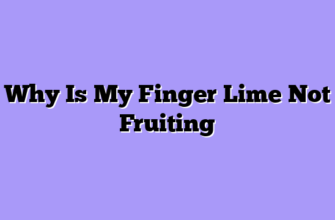Twenty-two years of exotic fruit farming, and I thought I’d seen it all. Then finger limes entered my life like a beautiful puzzle that refused to be solved. These Australian natives didn’t just challenge my growing techniques – they completely rewrote my understanding of what it means to match a plant with its perfect environment. Let me tell you about my decade-long journey to crack the code of finger lime growing zones.
When I first planted finger limes in my Kentucky orchard back in 2015, I was riding high on confidence. After all, I’d successfully adapted dragon fruit, passion fruit, and even jackfruit to climates they had no business thriving in. How hard could these little lime cousins be? Well, Mother Nature had quite the lesson waiting for me.

That’s when I realized something crucial: finger limes aren’t just picky about soil and water – they’re absolutely obsessed with their growing zone. These trees carry the genetic memory of Australia’s unique climate patterns, and trying to force them into the wrong environment is like asking a penguin to thrive in the desert.
Decoding the Climate Mystery
The breakthrough came during a particularly frustrating winter when I lost twelve more trees to unexpected cold snaps. I started digging deep into meteorological data, comparing my Kentucky microclimate with successful finger lime operations across the globe. What I discovered changed everything.
Finger limes thrive in USDA zones 9a through 11, but here’s the kicker – it’s not just about the numbers on the zone map. These trees demand specific conditions that create what I call the “Goldilocks effect” – everything has to be just right. Too hot, and the fruit development suffers. Too cold, and you’re looking at damaged or dead trees. Too humid, and diseases run rampant. Too dry, and the signature vesicles lose their pop.
The ideal finger lime growing zone feels like a Mediterranean vacation spot. We’re talking about average minimum temperatures between 20°F and 25°F in winter, with summer highs that don’t consistently exceed 90°F. But here’s where it gets interesting – finger limes actually prefer areas with distinct wet and dry seasons, mimicking their native Australian habitat.
I learned this lesson the hard way when I tried growing them in my greenhouse year-round with consistent conditions. The trees grew beautifully but produced mediocre fruit with vesicles that lacked that explosive burst of flavor. It turns out that finger limes need a period of mild stress – a dry season followed by adequate moisture – to trigger their best fruit production.
After analyzing weather patterns from successful growing regions, I identified the sweet spots:
- California’s coastal regions – zones 9b to 10a with ocean moderation
- Southern Florida – zones 10a to 11, but watch for hurricane damage
- Southern Texas – zones 9a to 10a, excellent for commercial production
- Hawaii – zones 10b to 11, though elevation matters significantly
- Protected microclimates – anywhere you can create zone 9+ conditions artificially
Mastering Microclimate Management
Here’s where my story gets really interesting. After losing those initial trees, I became obsessed with creating perfect microclimates. I spent months walking every square foot of my property with a thermometer, measuring temperature variations at different times of day and seasons. What I found amazed me.
My property, officially listed as zone 7a, actually contained pockets of zone 8b and even 9a conditions. These warmer spots occurred near south-facing slopes, areas protected by buildings or large trees, and surprisingly, near my pond where the water mass moderated temperature swings. It was like discovering hidden treasure in my own backyard.
I developed a systematic approach to microclimate selection and modification:
- Site assessment – Map temperature variations across your property throughout the year
- Protection installation – Use windbreaks, thermal mass, and strategic placement
- Drainage optimization – Ensure excellent drainage while maintaining moisture retention
- Elevation consideration – Higher ground often provides better cold air drainage
- Companion planting – Use larger trees and shrubs to create protective microclimates
- Season extension – Implement frost protection systems for borderline zones
The game-changer was discovering thermal mass effects. I started placing large, dark-colored water containers and stone walls near my finger lime trees. These absorbed heat during warm days and released it slowly during cool nights, effectively bumping my microclimate up by half a zone or more.
But the real breakthrough came when I partnered with my neighbor, Maria, who had a small vineyard. She taught me about cold air drainage – how cold air flows downhill like water, pooling in low areas. By planting my finger limes on gentle slopes with good air drainage, I eliminated most of my frost damage issues.
| Growing Zone | Winter Low | Success Rate | Special Considerations |
|---|---|---|---|
| 7a-8a | 0°F to 15°F | 20% | Requires extensive protection |
| 8b-9a | 15°F to 25°F | 70% | Needs microclimate management |
| 9b-10a | 25°F to 35°F | 95% | Ideal natural conditions |
| 10b-11 | 35°F+ | 90% | Watch for excessive heat stress |
The Sweet Rewards of Getting It Right
Fast forward to today, and my finger lime operation spans three carefully selected microclimates across my expanded property. I’ve learned to read the subtle signs that indicate optimal growing conditions – the way morning dew forms, how quickly soil dries after rain, the intensity of fruit coloration at different elevations.
My zone 9a microclimate produces the most consistent crops with exceptional vesicle quality. The trees here experience just enough winter chill to trigger proper dormancy, followed by ideal spring conditions for flowering and fruit set. The zone 8b area works well for hardier varieties, though I’ve learned to provide supplemental protection during extreme cold snaps.

The economic impact of getting the growing zone right has been staggering. My properly zoned trees now produce 15-20 pounds of fruit per tree annually, compared to the 2-3 pounds I was getting from stressed trees in unsuitable microclimates. When you’re selling finger limes for $50-60 per pound wholesale, that difference pays for a lot of microclimate improvements.
I’ve also discovered that different finger lime varieties have distinct zone preferences within the acceptable range. Red champagne varieties seem to prefer the warmer end of zone 9, developing better color intensity in slightly hotter conditions. Green varieties, on the other hand, maintain better acidity and vesicle structure in the cooler parts of their acceptable range.
The most rewarding aspect has been helping other farmers avoid my early mistakes. I now consult with growers across the country, helping them identify and develop suitable microclimates for finger lime production. Last year, I helped a farmer in North Carolina create a successful zone 8b operation using thermal mass, windbreaks, and strategic site selection.
Looking back on this journey, I realize that mastering finger lime growing zones taught me something profound about farming itself. Success isn’t just about following general guidelines – it’s about understanding the intricate dance between plant genetics, local climate, and human ingenuity. Every microclimate tells a story, and learning to read those stories has made me not just a better finger lime grower, but a better farmer overall.
Today, when I walk through my thriving finger lime groves and see trees heavy with those precious little fruits, I’m reminded that sometimes the greatest challenges lead to the sweetest victories. The key was learning to work with nature’s rules rather than fighting against them – finding that perfect sweet spot where Australian genetics meet American innovation.








